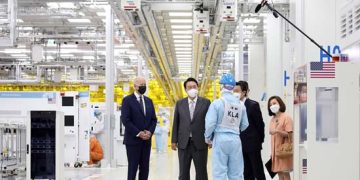When Joe Biden landed in South Korea last month – his first official trip to the country as U.S. President – he headed straight for Samsung’s massive semiconductor factory outside Seoul. There, he met with South Korean President Yoon Suk-yeol and Samsung Electronics Vice Chairman Lee Jae-yong, and praised the construction of a $17 billion Samsung semiconductor factory in Texas. The economic and strategic importance of semiconductors could not have been made any clearer.
Amid the COVID-19 pandemic, semiconductor supply disruptions forced a range of industries – from automobiles to consumer electronics – to slow or halt production. Reliable semiconductor supplies, it became clear, are vital to a country’s economic resilience. For the United States and China, they are also central to a strategic competition in which leadership in cutting-edge industries plays a crucial role.
As it stands, the U.S. has a bigger slice of the global semiconductor pie, owing to its strength in chip design and in the fabless segment of the industry. But the vast majority of chips are manufactured far from America’s shores, including at the Samsung factory in Xi’an, capital city of northwest China’s Shaanxi Province. And China – the world’s biggest chip market – is investing heavily in the sector as part of its effort to boost indigenous innovation. So, is the U.S. set to lose its semiconductor edge?
So far, China has struggled to catch up. First, the typical latecomer strategy – focused on building cheaper, low-end products – cannot be applied to semiconductors, because a more advanced “next-generation” memory chip tends to cost the same or less than its predecessors. Less advanced chips are thus virtually worthless.
This is not to say that incumbents’ position is unassailable. After all, South Korean firms like Samsung managed to overtake more established Japanese companies like Toshiba in semiconductors.
The key is a “leapfrogging” strategy: developing more advanced versions of a technology before the incumbent can. Such a strategy requires that the development of a technology follows a relatively predictable path – in the case of chips, upgrading from a capacity of one kilobyte to 2K, then 4K, and so on – and that companies have access to technology from abroad.
South Korean companies like Samsung never made the lowest-capacity chips. Instead, they used equipment and facilities imported from Sharp in Japan, and circuit designs licensed from Micron Technology in the U.S., to begin developing 64K chips immediately upon market entry.
Later, Samsung set up a research-and-development facility in California’s Silicon Valley, in order to develop designs for high-capacity (256K) chips ahead of Japanese firms. Its use of the “stacking method” for increasing chip complexity – rather than the “trenching method” used by firms like Toshiba – helped to propel progress. But Samsung continues to rely on high-tech components, parts, and supplies from Japanese and other foreign sources, and on software from the U.S. At a time when China’s access to foreign technologies and equipment is increasingly constrained, the country will have a hard time replicating this leapfrogging strategy. CGTN





